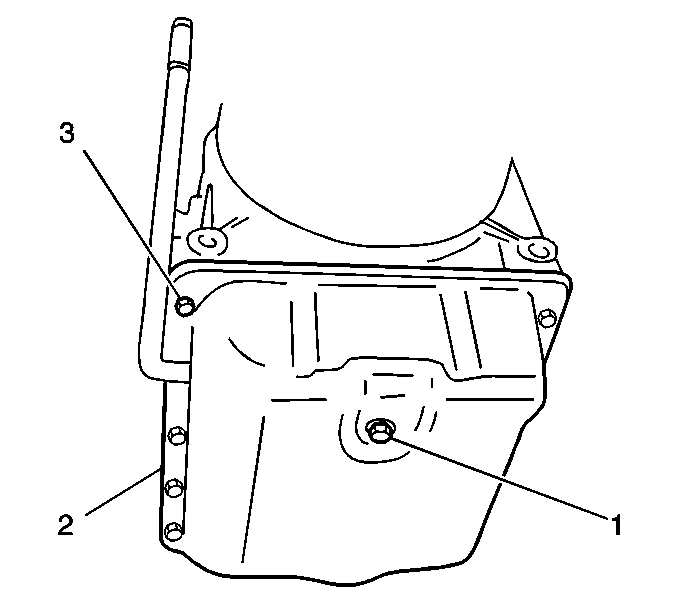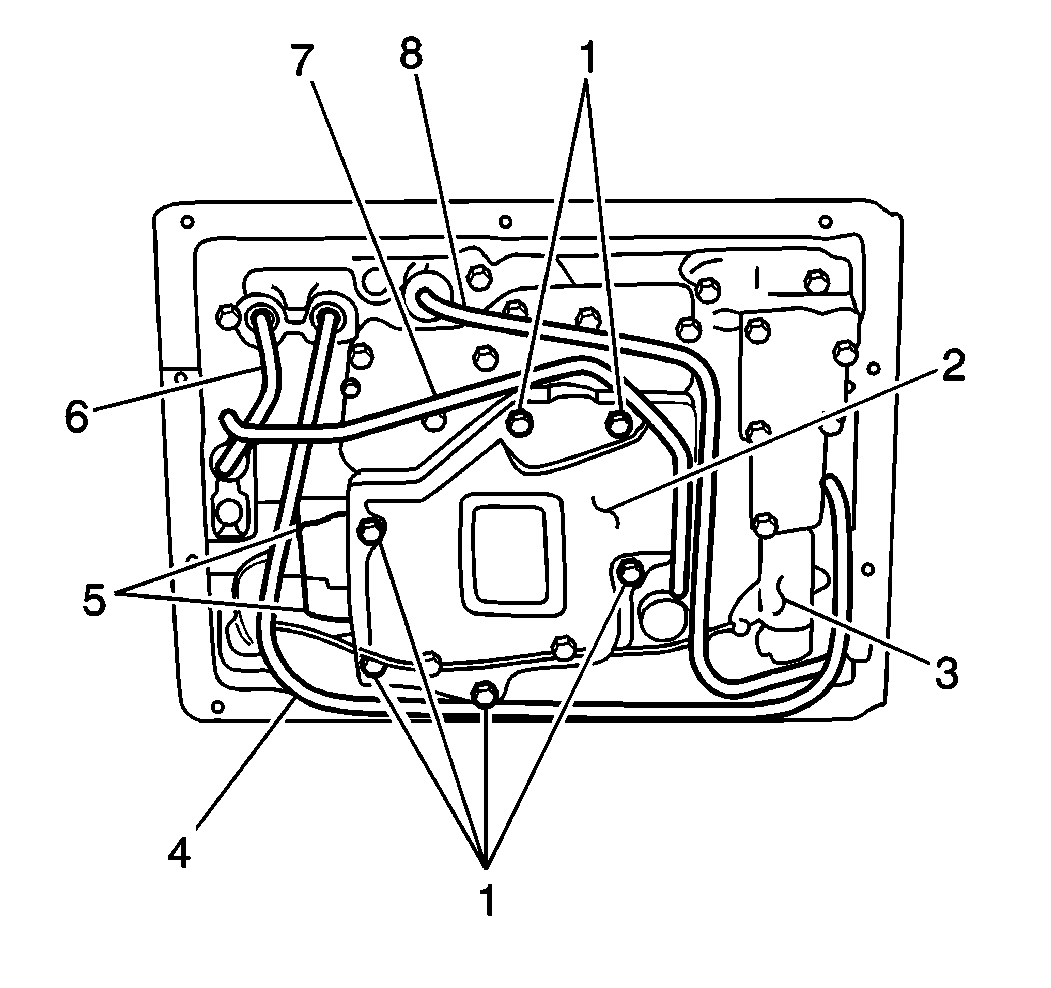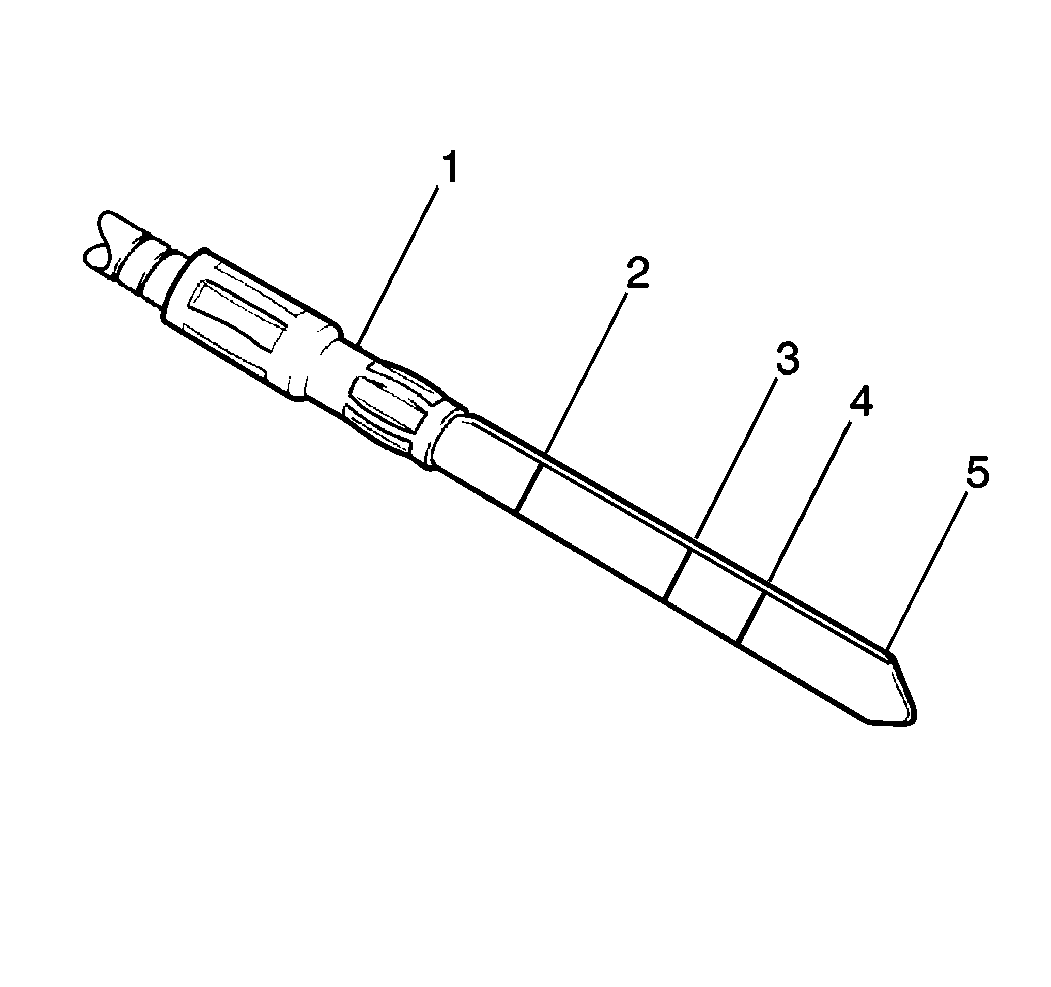Removal Procedure

- Raise the vehicle. Support the vehicle.
Refer to Lifting and Jacking the Vehicle in General Information.
Important: Removal of the propeller shaft from the transfer
case will result in fluid loss in four-wheel drive models.
- Place an index mark (reference mark) (1) on the propeller shaft pinion flange
and the front differential pinion flange of the transfer case to front differential
propeller shaft (four-wheel drive models).
- Remove the four nuts and the four bolts from the front differential pinion
flange (four-wheel drive models).
- Separate the pinion flange yoke from the front differential pinion flange
(four-wheel drive models).
- Position and support the transfer case to the front differential propeller
shaft away from the transmission fluid pan.

- Place a drain pan or suitable container
under the transmission drain plug (1).
- Remove the drain plug in order to allow the transmission fluid pan (2)
to drain.

- Remove the fourteen transmission fluid pan
bolts from the transmission fluid pan.
- Remove the transmission fluid pan and the gasket from the transmission.
- Remove the four fluid pipes in the following order: 7, 6, 4 and then 8.
- Remove the following items from the valve body:
| • | The fluid filter screen (2) |
| • | The fluid filter gasket |
| • | The fluid filter spacer |
| • | The fluid filter spacer gasket |
Important: A small amount of clutch material in the
bottom of the transmission fluid pan is a normal condition and is consistent with
normal transmission wear. The bottom of the fluid pan is equipped with a magnet that
will collect minute metal filings. However, if large amounts of clutch material, metal
shavings or other foreign matter are present, transmission disassembly and inspection
is indicated.
- Clean the fluid filter screen with solvent and air dry.
- Clean the transmission fluid pan with solvent and air dry.
- Clean the fluid pan magnets with solvent and air dry.
- Clean the transmission fluid pan.
- Clean the fluid filter screen gasket mating surfaces
- Inspect the fluid filter screen for tears or other damage. Replace as
necessary.
Installation Procedure

- Install a new fluid filter screen gasket
and fluid filter screen (2) to the valve body.
Notice: Use the correct fastener in the correct location. Replacement fasteners
must be the correct part number for that application. Fasteners requiring
replacement or fasteners requiring the use of thread locking compound or sealant
are identified in the service procedure. Do not use paints, lubricants, or
corrosion inhibitors on fasteners or fastener joint surfaces unless specified.
These coatings affect fastener torque and joint clamping force and may damage
the fastener. Use the correct tightening sequence and specifications when
installing fasteners in order to avoid damage to parts and systems.
- Secure the fluid filter screen (2) to the valve body with the six bolts (1).
Tighten
Tighten the fluid filter screen bolts to 5 N·m
(44 lb in).
- Install the four fluid pipes in the following order: 8, 4, 6 and then
7.
Important: Ensure the filler tube is properly connected
when installing the transmission pan.
- Install the new transmission fluid pan gasket and the transmission fluid pan
to the transmission.
- Secure the transmission fluid pan with the fourteen bolts.
Tighten
Tighten the transmission fluid pan bolts to 5 N·m
(44 lb in).

- Install the transmission drain plug (1)
into the transmission.
Tighten
Tighten the transmission drain plug to 17 N·m
(13 lb ft).
- Install the propeller shaft into the vehicle aligning the index marks
made during the front propeller shaft removal (four-wheel drive models).
- Secure the front propeller shaft with four bolts and four nuts.
Tighten
Tighten the front propeller shaft bolts and nuts
to 50 N·m (37 lb ft).
- Lower the vehicle.

- Refill the transmission as necessary using
the following steps:
| 10.1. | Place the vehicle on a level surface. |
| 10.2. | Remove the fluid level indicator. |
| 10.3. | Add approximately 1.5 liters (1.6 quarts) of Dexron®-III
automatic transmission fluid GM P/N 12346143, or the equivalent, into the fluid filler
tube. |
| 10.4. | Install the fluid level indicator into the fluid filler tube. |
| 10.5. | Apply the parking brake and block the vehicle wheels. |
| 10.6. | With the selector lever in the PARK position, start the engine. DO NOT
race the engine. |
| 10.7. | Run the engine at idle speed. |
| 10.8. | Move the selector lever through each range and return the selector lever
to the PARK position. |
| 10.9. | While the engine is running at idle remove the fluid level indicator from
the filler tube and wipe the indicator off. |
| 10.10. | Reinsert the fluid level indicator into the filler tube making sure it
is seated in its original position. |
| 10.11. | Remove the indicator and check the fluid level. The level should be between
the FULL HOT (2) and the LOW HOT (3) marks. If the level is below the LOW HOT mark,
add fluid to bring the level to the FULL HOT mark. Bringing the fluid level from the
LOW HOT mark to the FULL HOT mark requires 0.3 liters (0.3 quarts) of
fluid. Use Dexron®-III automatic transmission fluid GM P/N 12346143, or the equivalent. |






